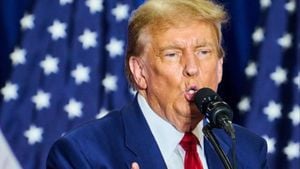China's yuan and stock markets experienced noticeable declines last week, coinciding with Donald Trump's declaration of victory over Kamala Harris in the recent U.S. presidential election. The announcement of Trump's potential return to presidency has heightened concerns over trade tensions, particularly with China, which could affect the global economic equilibrium drastically.
By the end of the trading day, the yuan showed signs of weakness, with the offshore yuan dropping significantly against the dollar, more than 900 basis points at one point, settling below the 7.19 mark. This shift indicated the immediate anxiety among international investors about how Trump's policies might impact U.S.-China relations. The notion of tariffs on Chinese goods added to the alarm, leading many experts to analyze what the future might hold for China's economy if Trump re-imagines trade relationships.
Currently, China's blue-chip CSI300 Index fell by 0.5%, and Hong Kong's Hang Seng Index, seen as reflective of foreign investor sentiment, plummeted by 2.3%. Notably, both JD.com and Alibaba saw their stock prices dip by approximately 4%. Trump's earlier propositions during his first term of imposing tariffs of 60% or more on imports from China are expected to loom large over market analyses, provoking both fear and speculation among investors.
Experts like Rong Ren Goh, who manage investments, noted how easily tariffs can be applied through presidential executive orders, which produced similar outcomes during Trump's first term. "Markets are now waiting to see if there will be more substantial policy changes or stimulus measures introduced soon," Goh stated, hinting at the potential for drastic shifts to China's economy under pressure from U.S. trade policies.
Trump's presidency could potentially catalyze not just renewed tariffs but also other forms of economic sanctions against China. With both major political parties displaying hawkish tendencies toward China, the return of Trump stirs apprehensions about unpredictable and aggressive economic policies. He could leverage various strategies, not solely tariffs, to challenge China’s rising influence. For now, this dread gives investors little choice but to hedge against the risk of fluctuated market conditions.
Despite these turbulent waters, China’s markets have been reforming from previous lows, gaining over 20% since late September owing to governmental efforts focused on stimulating economic growth and consumption. The current administration promises to tackle weaknesses within the real estate sector, hoping to stabilize the financial environment. Nevertheless, experts like Kenny Ng from China Everbright Securities have voiced concerns over how Trump's unpredictability could affect recovery, stating, “Although both parties show aggression toward China, Trump’s inconsistency means the market sentiments could sway rapidly based on announcements he's likely to make.”
Onshore markets remain hopeful for new stimulus measures to stabilize investor confidence, as the National People’s Congress (NPC) convenes to discuss future economic policies. Many market participants are keeping a close watch on outcomes from these meetings more than the election results.
It's not just the stock market witnessing upheaval; the exchange rate between the yuan and dollar is also becoming pivotal. An expert, Nick Marro, highlighted how the exchange rate might function as leverage for tariffs negotiations between the two giant economies. His insights suggest the potential for the yuan to act as collateral damage, symbolizing the negotiations' fluid nature between the U.S. and China.
Historical contexts showcase alarming patterns; during Trump's first presidency, the yuan fell approximately 5% when tariffs were first imposed, only to decline again by about 1.5% the following year as trade tensions intensified. These events contribute to worries about inflationary pressures associated with his policies, which could maintain high U.S. interest rates and destabilize currencies of trading partners, especially China.
Adding to these concerns, economists warn of possible inflation effects from Trump's proposed tariff strategies, warning they could spur inflationary rates within the U.S. and prompt adjustments to interest rates, thereby risking currency stability across the globe.
China’s debt is also under the microscope. It encounters increasing burdens amid fiscal pressures and administrative decisions, with the country contemplating significant new debts around $14 trillion over the next few years to stabilize its economy. With domestic consumption wobbly and global pressures mounting, these financial dynamics paint a complex picture of China's economic health balanced atop uncertain U.S. relations.
There is also chatter about the potential return of deflationary pressures, with companies potentially struggling to maintain prices amid slumping demand and excess production capacity. This situation is already leading several exporters to reevaluate their strategies, attempting to navigate the choppy waters of U.S. policy shifts and dwindling consumer appetites.
Despite these hurdles, analysts remain cautiously optimistic about some sectors, especially if China can redistribute resources effectively. This adaptability may allow it to counterbalance unfavorable U.S. policies with internal reforms and stimulus measures aimed at bolstering the economy.
Going forward, China faces mounting pressure to respond to external stimuli aggressively. Much depends on how quickly it can adjust to altering global conditions and meet the internal demands for economic growth. The outcome of the Trump presidency remains uncertain, but for now, the anxiety surrounding his potential trade policies looms heavily over China’s economic future.
Deeper scrutiny of markets, investor sentiments, and currency trends will pave the way for informed strategies going forward. The interplay between U.S. election outcomes and Chinese economy metrics will likely continue driving news and analyses for the foreseeable future.



